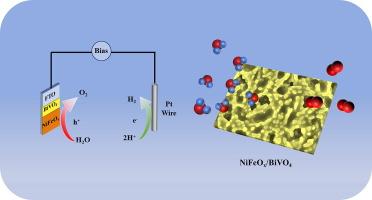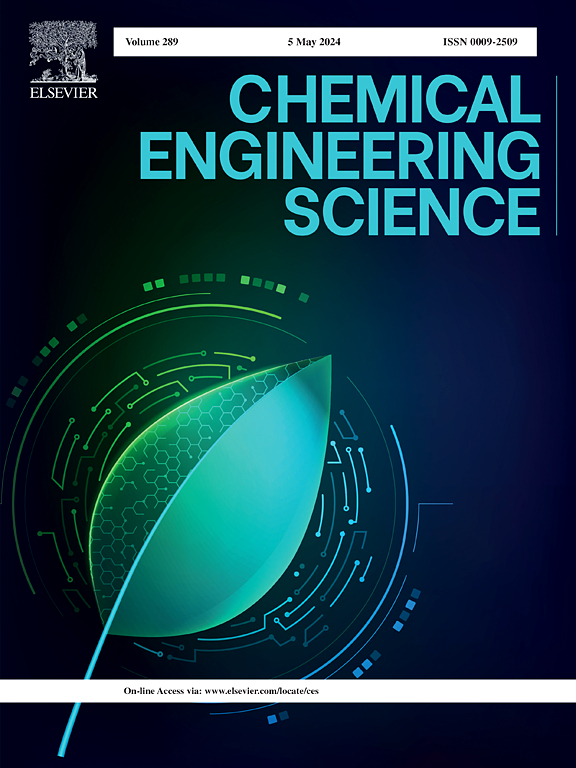Enhancement of BiVO4 photoanode surface oxygen evolution kinetics via Ni-Fe-ZIF derived bimetallic NiFeOx co-catalyst for water oxidation
IF 4.1
2区 工程技术
Q2 ENGINEERING, CHEMICAL
引用次数: 0
Abstract
The water oxidation kinetics on the surface of bismuth vanadate (BiVO4) photoanode is slow and the surface charge recombination is serious which hindering the photoelectrochemical (PEC) water splitting process. To enhance the PEC performance of BiVO4 and expedite the water oxidation process, in this work, a straightforward electrostatic adsorption and pyrolysis methods were devised to convert bimetallic Ni-Fe-zeolitic imidazolate frameworks (Ni-Fe-ZIF) molecular sieve into NiFeOx oxygen evolution co-catalyst and modified on BiVO4 photoanode surface (NiFeOx/BiVO4). The optimized NiFeOx/BiVO4 photoanode showed a high optical photocurrent density of 3.57 mA/cm2 at 1.23 V compared with reversible hydrogen electrode under AM 1.5G illumination with 4.4 times compared to the pure BiVO4 photoanode. The NiFeOx/BiVO4 composites photoanodes also exhibited the higher charge transfer efficiency of more than 77.8 % than the pure BiVO4 photoanode, indicating that the NiFeOx has excellent co-catalytic properties during PEC process. The improvement of photoelectric conversion efficiency can be attributed to the presence of NiFeOx layer with oxygen vacancies and more metal active sites on the BiVO4 surface which promoted the separation and transport of photoelectron-hole pairs and the surface oxygen evolution kinetics, thus significantly improving the photocurrent density.

通过 Ni-Fe-ZIF 衍生的双金属 NiFeOx 助催化剂提高 BiVO4 光阳极表面氧进化动力学以促进水氧化
钒酸铋(BiVO4)光阳极表面的水氧化动力学缓慢,表面电荷重组严重,阻碍了光电化学(PEC)分水过程。为了提高 BiVO4 的光电化学(PEC)性能并加速水的氧化过程,本研究设计了一种简单的静电吸附和热解方法,将双金属镍-芴-唑基咪唑啉框架(Ni-Fe-ZIF)分子筛转化为镍铁氧体氧进化助催化剂,并修饰在 BiVO4 光阳极表面(NiFeOx/BiVO4)上。优化后的 NiFeOx/BiVO4 光阳极在 AM 1.5G 光照下与可逆氢电极相比,在 1.23 V 电压下的光电流密度高达 3.57 mA/cm2,是纯 BiVO4 光阳极的 4.4 倍。NiFeOx/BiVO4 复合材料光阳极的电荷转移效率也比纯 BiVO4 光阳极高,超过 77.8%,表明 NiFeOx 在 PEC 过程中具有优异的协同催化性能。光电转换效率的提高可归因于 BiVO4 表面存在含氧空位的 NiFeOx 层和更多的金属活性位点,这促进了光电子-空穴对的分离和传输以及表面氧演化动力学,从而显著提高了光电流密度。
本文章由计算机程序翻译,如有差异,请以英文原文为准。
求助全文
约1分钟内获得全文
求助全文
来源期刊

Chemical Engineering Science
工程技术-工程:化工
CiteScore
7.50
自引率
8.50%
发文量
1025
审稿时长
50 days
期刊介绍:
Chemical engineering enables the transformation of natural resources and energy into useful products for society. It draws on and applies natural sciences, mathematics and economics, and has developed fundamental engineering science that underpins the discipline.
Chemical Engineering Science (CES) has been publishing papers on the fundamentals of chemical engineering since 1951. CES is the platform where the most significant advances in the discipline have ever since been published. Chemical Engineering Science has accompanied and sustained chemical engineering through its development into the vibrant and broad scientific discipline it is today.
 求助内容:
求助内容: 应助结果提醒方式:
应助结果提醒方式:


